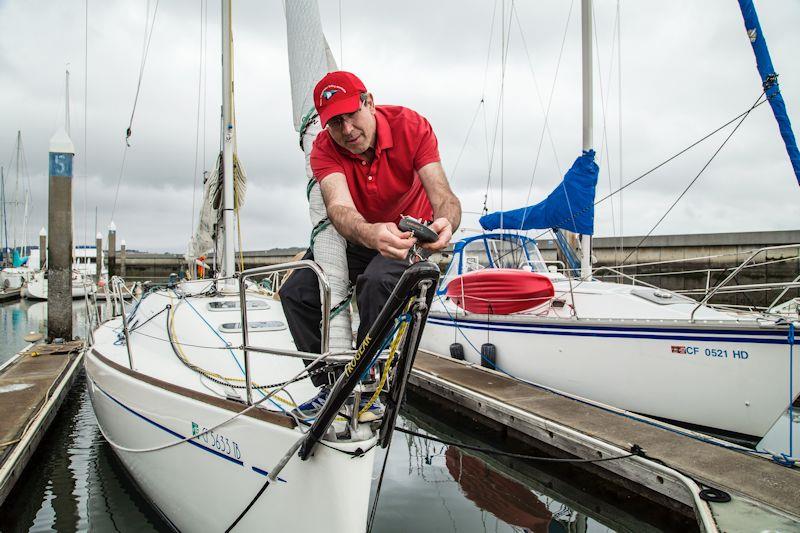
A Guide to Bowsprit Configuration from upffront.com
by Calanach Finlayson 29 Mar 2023 09:00 BST

A Guide to Bowsprit Configuration © Trogear
A bowsprit is now an almost inevitable feature of a racing yacht or performance cruiser and there are also a number of off-the-shelf retrofit options available. The uptake is due in part to the popularity of asymmetric downwind sails which offer ease of handing, particularly when sailing with reduced crew. But even for a predominantly symmetric spinnaker boat, a bowsprit is necessary for flying a code zero or other specialist reaching asymmetric.
In this article we look at how to best setup a bowsprit to suit your sail inventory.
Don't yet have a bowsprit?
If you are looking for a bowsprit for your boat, it's worth checking whether there are any dedicated options available from the yard. Alternatively, let's take a quick look at the standardised retrofit options available on the market. These are broadly split into two categories: A-frames and single tubes.
Carbon A-frame from Trogear
The A-frame sprits from Trogear are lightweight and stiff, making them just as suitable for racing as for cruising. Various mounting options exist, including compatibility with most anchor brackets. The big benefit of these sprits is that they don't clutter the foredeck. A bobstay is always required.
Carbon or aluminium single tube
Single tube sprits such as those from Selden and Facnor are typically much more affordable and can be self-supported without a bobstay. This is achieved by having approx. 50% of the total pole length fixed on the foredeck with the remainder projected forward.
As a result, these take up a significant amount of prime foredeck real estate. For high-load reaching sails a bobstay is required.
Finally, if you still haven't found what you need then a custom or semi-custom approach may be the only way. Look for a local yard working in stainless or composites who is able to make you an offer.
Non-furling asymmetrics
Let's move onto the setup. For a downwind asymmetric without a furler, the tack line is connected directly to the tack of the sail. This is the simplest setup requiring only a single block, ring or friction sheave at the end of the bowsprit.
If you want the ability to peel from one asymmetric to another then you will need either a second tackline parallel to the first, or you can use a peeling strop to temporarily fix the tack of the new sail before the tackline is transferred.
Depending on the type of bowsprit, a bobstay may not be necessary for downwind sails. For example, short stainless steel prodders, bowsprits integrated with the anchor bracket, or stiff single tubes like on a J boat typically don't have a bobstay.
Furling sails
Furling downwind asymmetrics and code zeros are also flown from the bowsprit but have slightly different requirements. A good rule for successful furling is to have an attachment point which does not allow the entire furler to rotate. A furler which is clipped onto a single tackline is liable to rotate inadvertently and wrap the furling line up with it.
There are a couple of ways to prevent this. One is to attach the furler to a fixed metal padeye on the bowsprit. This simple solution removes the need for an additional tackline running to the cockpit. It does however mean that you will need to be able to reach the attachment point! Facnor offer a fixed furler attachment for their bowsprits (see right)
Alternatively, use a 2:1 tackline where the dead end of the tackline has some separation from the working part. This separation prevents the furler from twisting once it is under load. The added benefit of a 2:1 tackline is better control of luff tension.
A reaching sail like a code zero creates a higher load case than a downwind sail and always needs a bobstay.
A bit of everything
If you are cruising then it's likely that you don't need the ability to peel from one asymmetric to another. In this case, a fixed padeye for a code zero or a single tackline for a non-furling sail is probably the way to go.
But if you are racing, then it's likely that you have a number of non-furling asymmetrics, perhaps a couple of furling sails, and you need the ability to peel from any sail to any other. In terms of bowsprit setup this is absolutely achievable and in fact it's probable that halyard management becomes the limiting factor in realising your ambitions of peeling away endlessly into the sunset.
To achieve this versatile setup, we need twin friction rings at the end of a the sprit for twin tacklines. Approximately 10cm aft of this we need an additional soft padeye or loop which will be used to create the 2:1. Both tacklines should have quick release snap shackles.
You now have a setup where each tackline can either run directly onto the tack of the sail, or be clipped back onto the soft padeye for a 2:1. With this you can peel in any combination you like. Of course this also requires you being able to reach the soft loop for the 2:1.
Summary
Adding a bowsprit to your boat allows you to increase the sail inventory and spend more time fast reaching. But it's worth planning the setup to suit all the sails you intend to use:
- A single tackline with a shackle is sufficient for a non-furling asymmetric
- Peeling between asymmetrics requires a peeling strop OR a second tackline
- Furlers should be clipped to a fixed padeye or 2:1 tackline to avoid twisting
- Adding a secondary attachment point allows a single tackline to be converted to 2:1
- Twin tacklines which both have a 2:1 option gives the most versatility
If you have any questions please feel free to email us at , or click the link below to see our full range:
